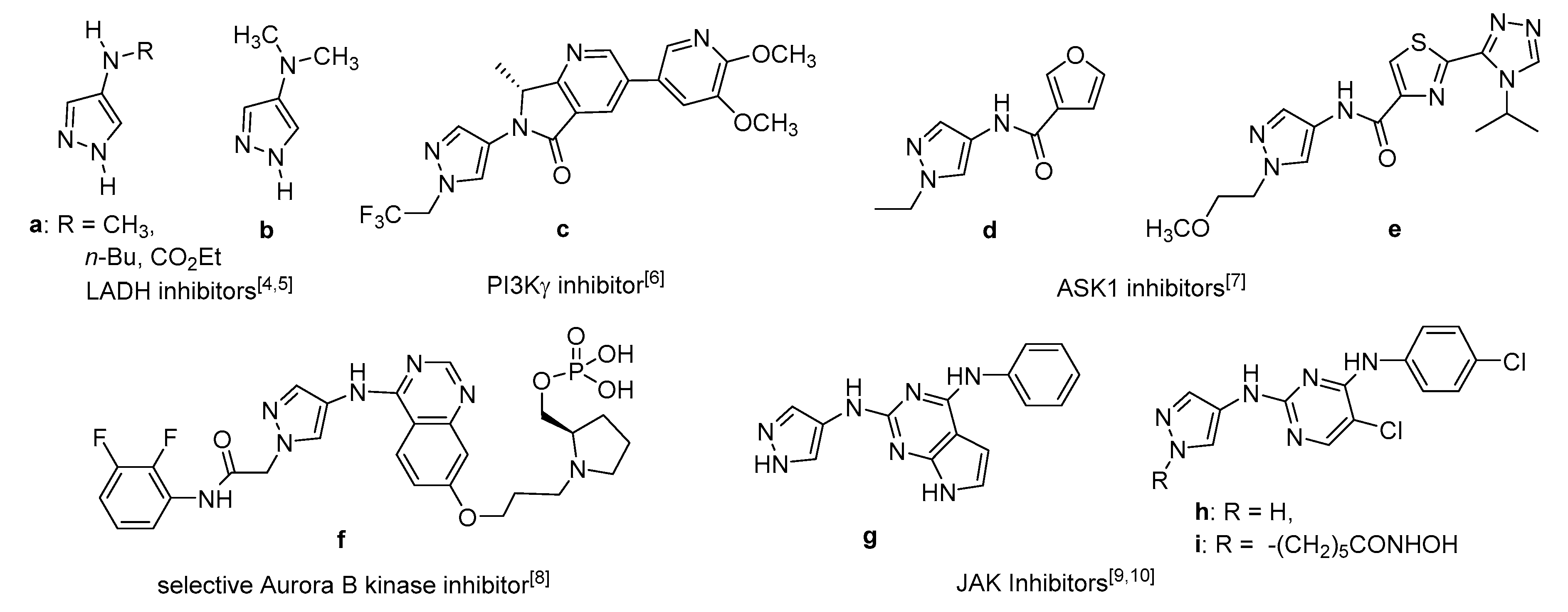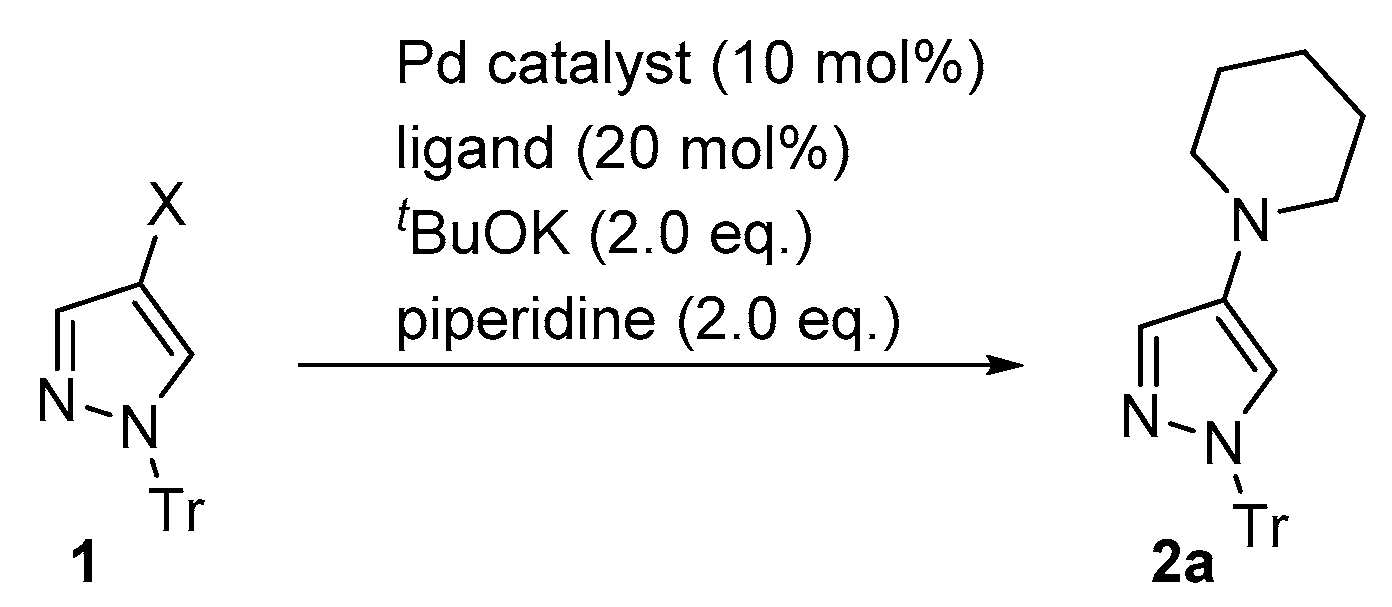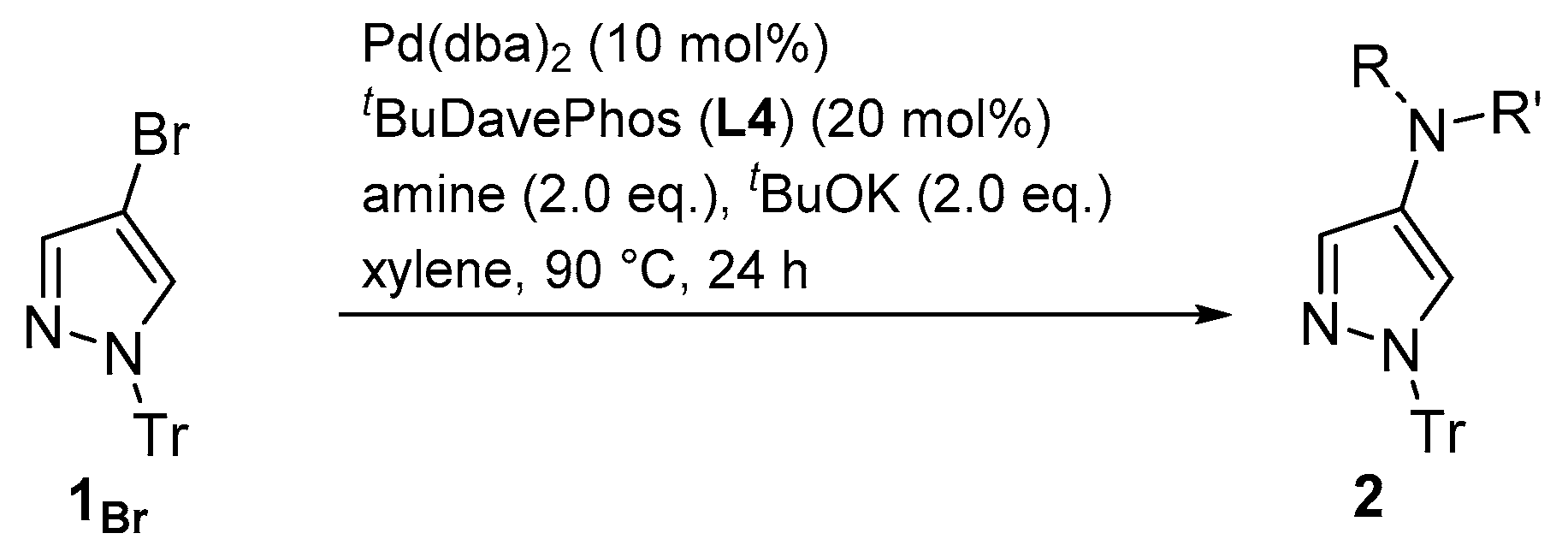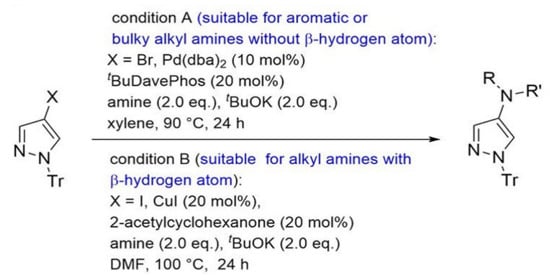C4-Alkylamination of C4-Halo-1H-1-tritylpyrazoles Using Pd(dba)2 or CuI
Abstract
1. Introduction
2. Results and Discussion
2.1. Pd(dba)2-Catalyzed Buchwald-Hartwig Coupling for C4-Amination of 4-halo-1H-1-tritylpyrazoles
2.2. CuI-Catalyzed Coupling for C4-Amination of 4-Halo-1H-1-tritylpyrazoles
3. Conclusions
4. Materials and Methods
Author Contributions
Funding
Acknowledgments
Conflicts of Interest
References
- Li, J.J. Pyrazoles, pyrazolones, and indazoles. In Heterocyclic Chemistry in Drug Discovery; Li, J.J., Ed.; Wiley-VCH: Weinheim, Germany, 2013; pp. 198–229. [Google Scholar]
- Brown, A.W. Recent developments in the chemistry of pyrazoles. Adv. Heterocycl. Chem. 2018, 126, 55–107. [Google Scholar]
- Karrouchi, K.; Radi, S.; Ramli, Y.; Taoufik, J.; Mabkhot, Y.N.; Al-aizari, F.A.; M’hammed, A. Synthesis and pharmacological activities of pyrazole derivatives: A review. Molecules 2018, 23, 134. [Google Scholar] [CrossRef] [PubMed]
- Tolf, B.-R.; Dahlbom, R.; Aakeson, A.; Theorell, H. Synthetic inhibitors of alcohol dehydrogenase. Pyrazoles containing polar groups directly attached to the pyrazole ring in the 4-position. Acta Pharm. Suec. 1985, 22, 147–156. [Google Scholar]
- Tolf, B.-R.; Dahlbom, R.; Akeson, A.; Theorell, H. 4-Substituted pyrazoles as inhibitors of liver alcohol dehydrogenase. Structure-activity relationships. In Biologically Active Principles of Natural Products; Voelter, W., Daves, D.G., Eds.; Thieme Medical Publishers: Stuttgart, Germany, 1984; pp. 265–277. [Google Scholar]
- Come, J.H.; Collier, P.N.; Henderson, J.A.; Pierce, A.C.; Davies, R.J.; Le, T.A.; O’Dowd, H.; Bandarage, U.K.; Cao, J.; Deininger, D.; et al. Design and Synthesis of a Novel Series of Orally Bioavailable, CNS-Penetrant, Isoform Selective Phosphoinositide 3-Kinase γ (PI3Kγ) Inhibitors with Potential for the Treatment of Multiple Sclerosis (MS). J. Med. Chem. 2018, 61, 5245–5256. [Google Scholar] [CrossRef] [PubMed]
- Gibson, T.S.; Johnson, B.; Fanjul, A.; Halkowycz, P.; Dougan, D.R.; Cole, D.; Swann, S. Structure-based drug design of novel ASK1 inhibitors using an integrated lead optimization strategy. Bioorg. Med. Chem. Lett. 2017, 27, 1709–1713. [Google Scholar] [CrossRef]
- Foote, K.M.; Mortlock, A.A.; Heron, N.M.; Jung, F.H.; Hill, G.B.; Pasquet, G.; Brady, M.C.; Green, S.; Heaton, S.P.; Kearney, S.; et al. Synthesis and SAR of 1-acetanilide-4-aminopyrazole-substituted quinazolines: Selective inhibitors of Aurora B kinase with potent antitumor activity. Bioorg. Med. Chem. Lett. 2008, 18, 1904–1909. [Google Scholar] [CrossRef]
- Liang, X.; Zang, J.; Zhu, M.; Gao, Q.; Wang, B.; Xu, W.; Zhang, Y. Design, Synthesis, and Antitumor Evaluation of 4-Amino-(1H)-pyrazole Derivatives as JAKs Inhibitors. ACS Med. Chem. Lett. 2016, 7, 950–955. [Google Scholar] [CrossRef]
- Liang, X.; Zang, J.; Li, X.; Tang, S.; Huang, M.; Geng, M.; Chou, C.J.; Li, C.; Cao, Y.; Xu, W.; et al. Discovery of novel Janus kinase (JAK) and histone deacetylase (HDAC) dual inhibitors for the treatment of hematological malignancies. J. Med. Chem. 2019, 62, 3898–3923. [Google Scholar] [CrossRef]
- Jiang, L.; Buchwald, S.L. Palladium-Catalyzed Aromatic Carbon-Nitrogen Bond Formation in Metal-Catalyzed Cross-Coupling Reactions, 2nd ed.; De Meijere, A., Diederich, F., Eds.; Wiley-VCH Verlag GmbH & Co.: Weinheim, Germany, 2004; Volume 2, pp. 699–760. [Google Scholar]
- Dorel, R.; Grugel, C.P.; Haydl, A.M. The Buchwald–Hartwig Amination after 25 Years. Angew. Chem. Int. Ed. 2019, 58, 17118–17129. [Google Scholar] [CrossRef]
- Muci, A.R.; Buchwald, S.L. Practical palladium catalysts for C-N and C-O bond formation. Top. Curr. Chem. 2002, 219, 131–209. [Google Scholar]
- Altman, R.A.; Fors, B.P.; Buchwald, S.L. Pd-catalyzed amination reactions of aryl halides using bulky biarylmonophosphine ligands. Nat. Protoc. 2007, 2, 2881–2887. [Google Scholar] [CrossRef] [PubMed]
- Hartwig, J.F. Evolution of a fourth-generation catalyst for the amination and thioetherification of aryl halides. Acc. Chem. Res. 2008, 41, 1534–1544. [Google Scholar] [CrossRef] [PubMed]
- Hartwig, J.F. “Palladium-catalyzed amination of aryl halides and related reactions”. In Handbook of Organopalladium Chemistry for Organic Synthesis; Negishi, E., Ed.; John Wiley & Sons, Inc.: Hoboken, NJ, USA, 2002; Volume 1, pp. 1051–1096. [Google Scholar]
- Louie, J.; Hartwig, J.F. Palladium-catalyzed synthesis of arylamines from aryl halides. Mechanistic studies lead to coupling in the absence of tin reagents. Tetrahedron Lett. 1995, 36, 3609–3612. [Google Scholar] [CrossRef]
- Ingoglia, B.T.; Wagen, C.C.; Buchwald, S.L. Biaryl monophosphine ligands in palladium-catalyzed C–N coupling: An updated User’s guide. Tetrahedron 2019, 75, 4199–4211. [Google Scholar] [CrossRef]
- Maiti, D.; Fors, B.P.; Henderson, J.L.; Nakamura, Y.; Buchwald, S.L. Palladium-catalyzed coupling of functionalized primary and secondary amines with aryl and heteroaryl halides: Two ligands suffice in most cases. Chem. Sci. 2011, 2, 57–68. [Google Scholar] [CrossRef]
- Su, M.; Buchwald, S.L. Bulky biaryl phosphine ligands for palladium-catalyzed amidation of five-membered heterocycles as electrophiles. Angew. Chem. Int. Ed. 2012, 51, 4710–4713. [Google Scholar] [CrossRef]
- Su, M.; Hoshiya, N.; Buchwald, S.L. Palladium-catalyzed amidation of five-membered heterocyclic bromides. Org. Lett. 2014, 16, 832–835. [Google Scholar] [CrossRef]
- Park, B.Y.; Pirnot, N.T.; Buchwald, S.L. Visible light-mediated (hetero)aryl amidation using Ni(II) salts and photoredox catalysis in flow: A synthesis of tetracaine. J. Org. Chem. 2020, 85, 3234–3244. [Google Scholar] [CrossRef]
- Usami, Y.; Tsujiuchi, Y.; Machiya, Y.; Chiba, A.; Ikawa, T.; Yoneyama, H.; Harusawa, S. Synthetic challenges in the construction of 8- to 10-Membered Pyrazole-fused rings via ring-closing metathesis. Heterocycles 2020, 101, 496–511. [Google Scholar] [CrossRef]
- Usami, Y.; Tatsui, Y.; Sumimoto, K.; Miyamoto, A.; Koito, N.; Yoneyama, H.; Harusawa, S. 3-Trifluoromethansulfonyloxy-4,7-dihidropyrazolo[1,5-a]pyridine via ring-closing metathesis: Synthesis and transformation to withasomnine homologs. Heterocycles 2020, 103. in press. [Google Scholar]
- Ichikawa, H.; Ohno, Y.; Usami, Y.; Arimoto, M. Synthesis of 4-Arylpyrazoles via PdCl2(dppf) catalyzed cross-coupling reaction with Grignard reagents. Heterocycles 2006, 68, 2247–2252. [Google Scholar] [CrossRef]
- Ichikawa, H.; Nishioka, M.; Arimoto, M.; Usami, Y. Synthesis of 4-Aryl-1H-pyrazoles by Suzuki-Miyaura cross coupling reaction between 4-Bromo-1H-1-tritylpyrazole and arylboronic acids. Heterocycles 2010, 81, 1509–1516. [Google Scholar] [CrossRef]
- Ichikawa, H.; Ohfune, H.; Usami, Y. Microwave-assisted selective synthesis of 2H-indazoles via double Sonogashira coupling of 3,4-diiodopyrazoles and Bergman-Masamune cycloaromatization. Heterocycles 2010, 81, 1651–1659. [Google Scholar] [CrossRef]
- Usami, Y.; Ichikawa, H.; Harusawa, H.S. Heck-Mizoroki reaction of 4-Iodo-1H-pyrazoles. Heterocycles 2011, 83, 827–835. [Google Scholar] [CrossRef]
- Bhunia, S.; Pawar, G.G.; Kumar, S.V.; Jiang, Y.; Ma, D. Selected copper-based reactions for C-N, C-O, C-S, and C-C bond formation. Angew. Chem. Int. Ed. 2017, 56, 16136–16179. [Google Scholar] [CrossRef] [PubMed]
- Kwong, F.Y.; Klapars, A.; Buchwald, S.L. Copper-catalyzed coupling of alkylamines and aryl iodide: An efficient system even in an air atmosphere. Org. Lett. 2002, 4, 581–584. [Google Scholar] [CrossRef] [PubMed]
- Kwong, F.Y.; Buchwald, S.L. Mild and efficient copper-catalyzed amination of aryl bromides with primary alkylamines. Org. Lett. 2003, 5, 793–796. [Google Scholar] [CrossRef]
- Shafir, A.; Buchwald, S.L.J. Highly selective room-temperature copper-catalyzed C−N coupling reactions. J. Am. Chem. Soc. 2006, 128, 8742–8743. [Google Scholar] [CrossRef]
- Jiang, S.; Dong, X.; Qiu, Y.; Xiaoxing, D.C.; Wu, X.; Jiang, S. A new ligand for copper-catalyzed amination of aryl halides to primary (hetero)aryl amines. Tetrahedron Lett. 2020, 61, 151683. [Google Scholar] [CrossRef]
- Luo, T.; Wan, J.-P.; Liu, Y. Toward C2-nitrogenated chromones by copper-catalyzed β-C(sp2)–H N-heteroarylation of enaminones. Org. Chem. Front. 2020, 7, 1107. [Google Scholar] [CrossRef]
- Liu, W.; Xu, J.; Chen, X.; Zhang, F.; Xu, Z.; Wang, D.; He, Y.; Xia, X.; Zhang, X.; Liang, Y. CuI/2-Aminopyridine 1-Oxide Catalyzed Amination of Aryl Chlorides with Aliphatic Amines. Org. Lett. 2020, 22, 7486–7490. [Google Scholar] [CrossRef] [PubMed]
- Lyakhovich, M.S.; Averin, A.D.; Grigorova, O.K.; Roznyatovsky, V.A.; Maloshitskaya, O.A.; Beletskaya, I.P. Cu(I)- and Pd(0)-catalyzed arylation of oxadiamines with fluorinated halogenobenzenes: Comparison of efficiency. Molecules 2020, 25, 1084. [Google Scholar] [CrossRef] [PubMed]
Sample Availability: Not available. |



| Entry a | Substrate | Pd Catalyst | Ligand d | Solvent | Temperature (°C) | Time | Yield 2a (%) |
|---|---|---|---|---|---|---|---|
| 1 | 1I: X = I | Pd(dba)2 | L1 | xylene | 160 (MW b) | 10 min | 0 |
| 2 | 1I | Pd(dba)2 | L2 | xylene | 160 (MW) | 10 min | 0 |
| 3 | 1I | Pd(dba)2 | L3 | xylene | 160 (MW) | 10 min | 0 |
| 4 | 1I | Pd(dba)2 | L4 | xylene | 160 (MW) | 10 min | 21 |
| 5 | 1I | PdCl2 | L4 | xylene | 160 (MW) | 10 min | 9 |
| 6 | 1I | Pd(OAc)2 | L4 | xylene | 160 (MW) | 10 min | 20 |
| 7 | 1I | PEPPSI-IPr | L4 | xylene | 160 (MW) | 10 min | 13 |
| 8 c | 1I | Pd(dba)2 | L4 | xylene | 160 (MW) | 10 min | 52 |
| 9 c | 1I | Pd(dba)2 | L4 | toluene | 160 (MW) | 10 min | 30 |
| 10 c | 1I | Pd(dba)2 | L4 | mesitylene | 160 (MW) | 10 min | 49 |
| 11 c | 1I | Pd(dba)2 | L4 | 1,4-dioxane | 160 (MW) | 10 min | 32 |
| 12 c | 1I | Pd(dba)2 | L4 | THF | 160 (MW) | 10 min | 0 |
| 13 | 1I | Pd(dba)2 | L4 | xylene | rt | 24 h | 7 |
| 14 | 1I | Pd(dba)2 | L4 | xylene | 60 | 24 h | 19 |
| 15 | 1I | Pd(dba)2 | L4 | xylene | 90 | 24 h | 48 |
| 16 | 1Br: X = Br | Pd(dba)2 | L4 | xylene | 90 | 24 h | 60 |
| 17 | 1Cl: X = Cl | Pd(dba)2 | L4 | xylene | 90 | 24 h | 40 |
| 18 | 1Br | Pd(dba)2 | L4 | xylene | 70 | 24 h | 43 |
| 19 | 1Br | Pd(dba)2 | L4 | xylene | 140 | 24 h | 23 |


| Entry. | Amine | Product | Yield (%) |
|---|---|---|---|
| 1 | piperidine | 2a: R = R’ = -CH2CH2CH2CH2CH2- | 60 |
| 2 | morpholine | 2b: R = R’ = -CH2CH2OCH2CH2- | 67 |
| 3 | pyrrolidine | 2c: R = R’ = -CH2CH2CH2CH2- | 7 |
| 4 | allylamine | 2d: R = CH2CH=CH2, R’ = H | 6 |
| 5 | n-propylamine | 2e: R = CH2CH2CH3, R’ = H | 24 |
| 6 | n-butylamine | 2f: R = CH2CH2CH2CH3, R’ = H | 17 |
| 7 | isobutylamine | 2g: R = CH2CH(CH3)2, R’ = H | 28 |
| 8 | isoamylamine | 2h: R = CH2CH2CH(CH3)2, R’ = H | 20 |
| 9 | isopropylamine | 2i: R = CH(CH3)2, R’ = H | 0 |
| 10 | PhCH2NH2 | 2j: R = CH2Ph, R’ = H | 0 |
| 11 | PhCH2CH2NH2 | 2k: R = CH2CH2Ph, R’ = H | 30 |
| 12 | PhCH2CH2CH2NH2 | 2l: R = CH2CH2CH2Ph, R’ = H | 34 |
| 13 a | adamantylamine | 2m: R = adamantyl, R’ = H | 90 |
| 14 a | tert-butylamine | 2n: R = CH(CH3)3, R’ = H | 53 |
| 15 a | aniline | 2o: R = Ph, R’ = H | 94 |
| 16 a | 2-methoxyaniline | 2p: R = 2-MeOPh, R’ = H | 91 |
| 17 a | 1-naphthylamine | 2q: R = naphth-1-yl, R’ = H | 85 |
| 18 a | N,N-diphenylamine | 2r: R = R’ = Ph | 45 |

| Entry a | Substrate | Cu Catalyst | Ligand c | Temperature (°C) | Yield 2d (%) |
|---|---|---|---|---|---|
| 1 b | 1I: X = I | CuI | L5 | 100 | 17 |
| 2 | 1I | CuI | L5 | 100 | 72 |
| 3 | 1I | CuI | L6 | 100 | 68 |
| 4 | 1I | CuI | L7 | 100 | 12 |
| 5 | 1I | CuI | L6 | rt | 0 |
| 6 | 1I | CuI | L6 | 70 | 41 |
| 7 | 1I | CuI | L6 | 130 | 9 |
| 8 | 1I | CuI | L6 | 100 | 52 |
| 9 | 1I | CuI2 | L6 | 100 | 57 |
| 10 | 1I | Cu(OAc)2 | L6 | 100 | 58 |
| 11 | 1I | Cu2O | L6 | 100 | 16 |
| 12 | 1I | CuCT | L6 | 100 | 50 |
| 13 | 1I | [CuOTf]2.C6H6 | L6 | 100 | 70 |
| 14 | 1Br: X = Br | CuI | L6 | 100 | 66 |
| 15 | 1Cl: X = Cl | CuI | L6 | 100 | 0 |


| Entry | Amine | Product | Yield (%) |
|---|---|---|---|
| 1 | piperidine | 2a | 21 |
| 2 | morpholine | 2b | 22 |
| 3 | pyrrolidine | 2c | 43 |
| 4 | allylamine | 2d | 68 |
| 5 | n-propylamine | 2e | 75 |
| 6 | n-butylamine | 2f | 62 |
| 7 | isobutylamine | 2g | 70 |
| 8 | isoamylamine | 2h | 62 |
| 9 | isopropylamine | 2i | 57 |
| 10 | PhCH2NH2 | 2j | 55 |
| 11 | Ph CH2CH2NH2 | 2k | 53 |
| 12 | Ph CH2 CH2CH2NH2 | 2l | 69 |
| 13 | adamantylamine | 2m | 0 |
| 14 | tert-butylamine | 2n | 0 |
| 15 | aniline | 2o | 15 |
| 16 | 1-naphthylamine | 2q | 0 |
| 17 | N,N-diphenylamine | 2r | 0 |
© 2020 by the authors. Licensee MDPI, Basel, Switzerland. This article is an open access article distributed under the terms and conditions of the Creative Commons Attribution (CC BY) license (http://creativecommons.org/licenses/by/4.0/).
Share and Cite
Usami, Y.; Tatsui, Y.; Yoneyama, H.; Harusawa, S. C4-Alkylamination of C4-Halo-1H-1-tritylpyrazoles Using Pd(dba)2 or CuI. Molecules 2020, 25, 4634. https://doi.org/10.3390/molecules25204634
Usami Y, Tatsui Y, Yoneyama H, Harusawa S. C4-Alkylamination of C4-Halo-1H-1-tritylpyrazoles Using Pd(dba)2 or CuI. Molecules. 2020; 25(20):4634. https://doi.org/10.3390/molecules25204634
Chicago/Turabian StyleUsami, Yoshihide, Yuya Tatsui, Hiroki Yoneyama, and Shinya Harusawa. 2020. "C4-Alkylamination of C4-Halo-1H-1-tritylpyrazoles Using Pd(dba)2 or CuI" Molecules 25, no. 20: 4634. https://doi.org/10.3390/molecules25204634
APA StyleUsami, Y., Tatsui, Y., Yoneyama, H., & Harusawa, S. (2020). C4-Alkylamination of C4-Halo-1H-1-tritylpyrazoles Using Pd(dba)2 or CuI. Molecules, 25(20), 4634. https://doi.org/10.3390/molecules25204634







